Let us all agree on one thing: Growing a B2B Company is hard, especially in 2025.
It’s slower, messier, and rarely linear when compared to B2C.
Channels saturate fast, playbooks break often, money dwindles, and results take time.
At ONSAAS, we’ve spoken with dozens of founders, growth marketers, and operators going through this grind daily. We’ve also tested strategies across platforms, tools, and funnels, not for vanity metrics, but for real pipelines.
This list isn’t theory. Or just fluff
It’s what’s working in today’s high-stakes, competitive B2B environment.
We can’t iterate this more: Even the best growth strategy will fail if your fundamentals aren’t in place. If your positioning is vague, your ICP is off, or your sales process leaks, no tactic can save you. Solid growth starts with clear messaging, a real problem worth solving, and a tight alignment between marketing and sales.
That being said, here are some basic ideas to help you nail your foundation and elevate your positioning before scaling.
Many early-stage B2B companies make this mistake: they start correctly by identifying their Total Addressable Market (TAM) but fail to recognize their share of the right audience. While knowing your TAM can give you a broader view of who your audiences are, in reality, you are simply casting a net wider, hoping that you will land with a prized catch.
For example, take a B2B SaaS startup building a project management tool for remote teams. They identify their Total Addressable Market as “any company with remote employees”, which is a TAM of millions.
Sounds promising, right?
But here’s what will happen:
What if they change their ICP to Mid-sized SaaS companies and Remote-first product teams?
These teams:
Suddenly, messaging clicks. Close rates rise. Retention improves.
Why?
Because the product is no longer trying to be everything to everyone. It's solving a real problem for the right audience.
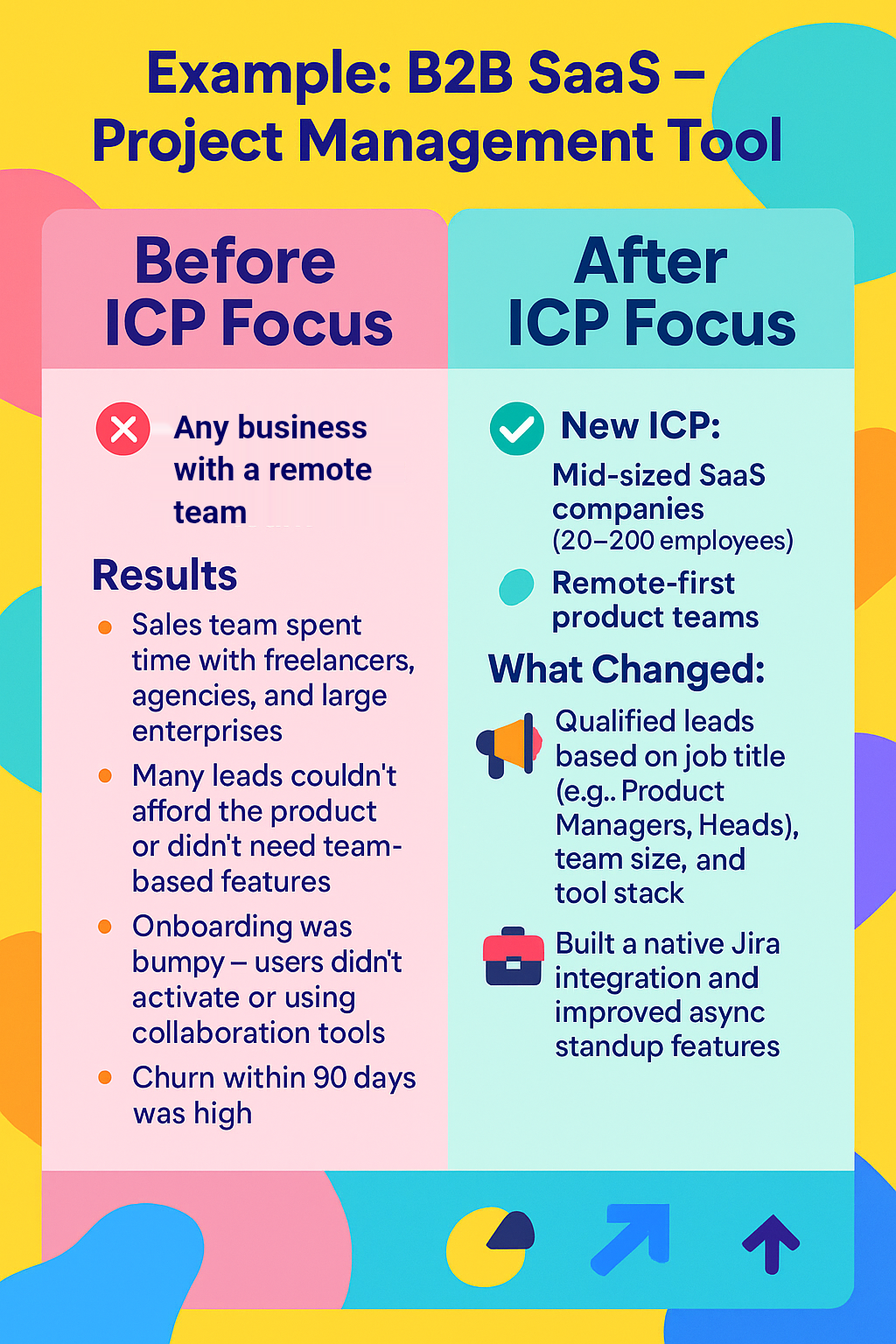
In B2B, your customer usually knows what you’re offering or is aware they have a problem.
That’s the good news.
The hard part?
You're not just convincing a single buyer; you're navigating endless committees and budget cuts.
So, a focused ICP helps you reduce the noise by

In B2B, what sets you apart isn’t your features. It’s the clarity of the problem you solve and how well you help your buyers connect the dots between their pain and your solution. Customers don’t care about passion projects or sleek branding unless the offering speaks to a real, recognizable need.
Truly differentiated companies understand that they’re not just selling to personas, they’re selling to people inside systems. A CEO and a Marketing Director might both be decision-makers, but they care about different things. The companies that win tailor their messaging to each, instead of trying to please everyone with vague positioning.
So, how do you stand out?
Sustainable B2B growth depends on internal alignment. When sales, marketing, and product operate in silos, you get disconnected messaging, wasted effort, and leaky funnels. However, when these teams align around shared metrics, feedback loops, and collective goals, growth becomes a coordinated effort rather than a guessing game.
Without support from a strong outbound sales motion, even the best campaigns struggle to drive real results. A marketer's job isn’t just to generate leads. It’s to create the conditions for meaningful conversations. That only happens when sales and marketing are working toward the same outcomes. In B2B, the person attending your first sales call isn’t always the final decision-maker. Often, they’ll need to convince their CEO or leadership team. Without the right tools, they’re pitching your product with nothing more than their memory of a demo.
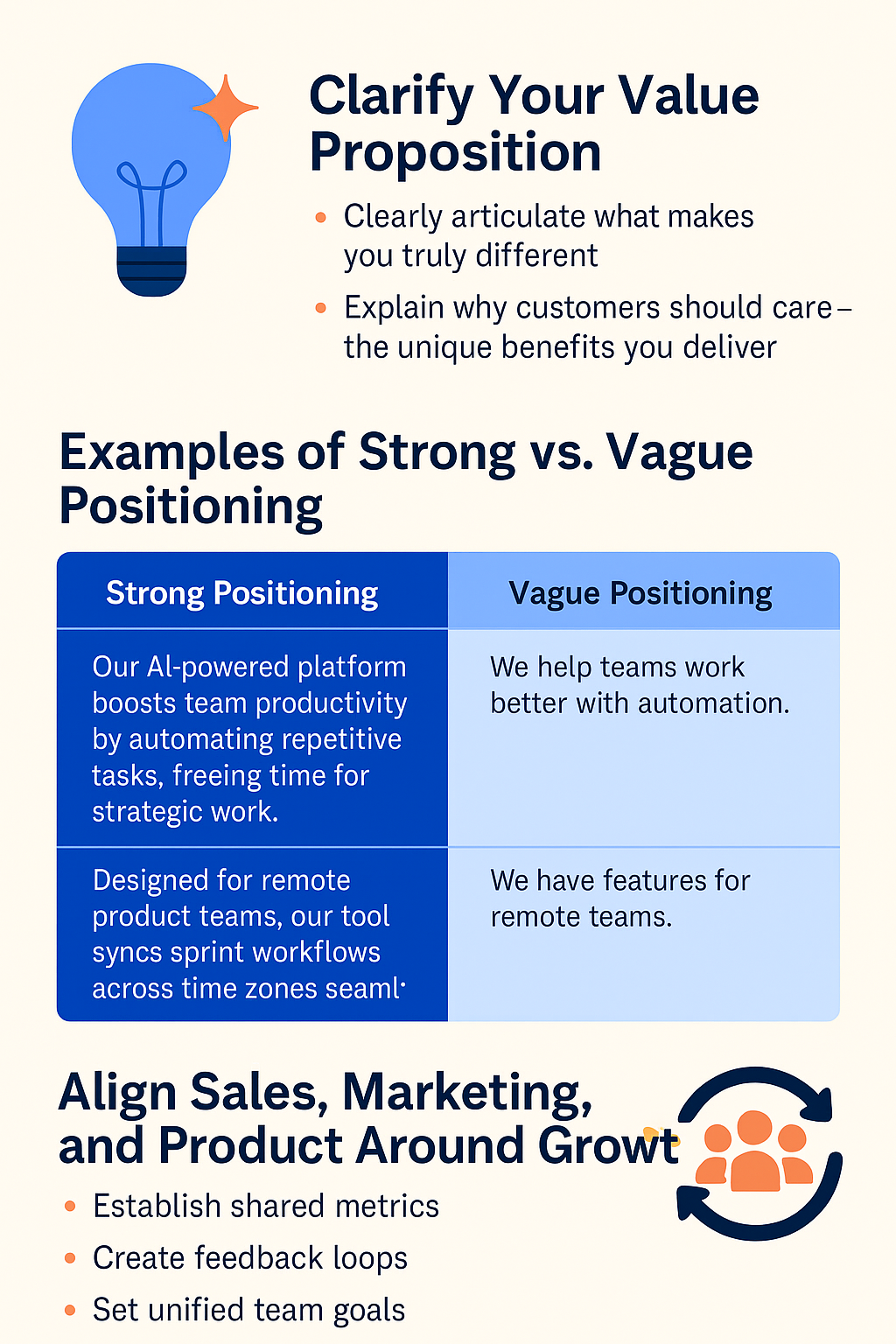
Alignment means sharing pipeline and retention goals across functions. It means learning from each other and bringing sales call insights back to marketing, as well as product usage patterns back to sales. Most importantly, it means recognizing that growth doesn’t belong to one team. It belongs to the system.
SEO is changing. Agreed.
Traditional keyword-stuffing techniques and inserting semantic keywords solely for the sake of gaining more visibility are no longer effective. Search is all about increasing the brand authority, proving your expertise, and earning mentions across AI overviews. In 2025, SEO is shifting towards Generative Engine Optimization (GEO) and Answer Engine Optimization (AEO). These approaches focus on optimizing content for AI-driven search results and direct answers, rather than traditional keyword rankings.
So, what can you do to upend your SEO game?
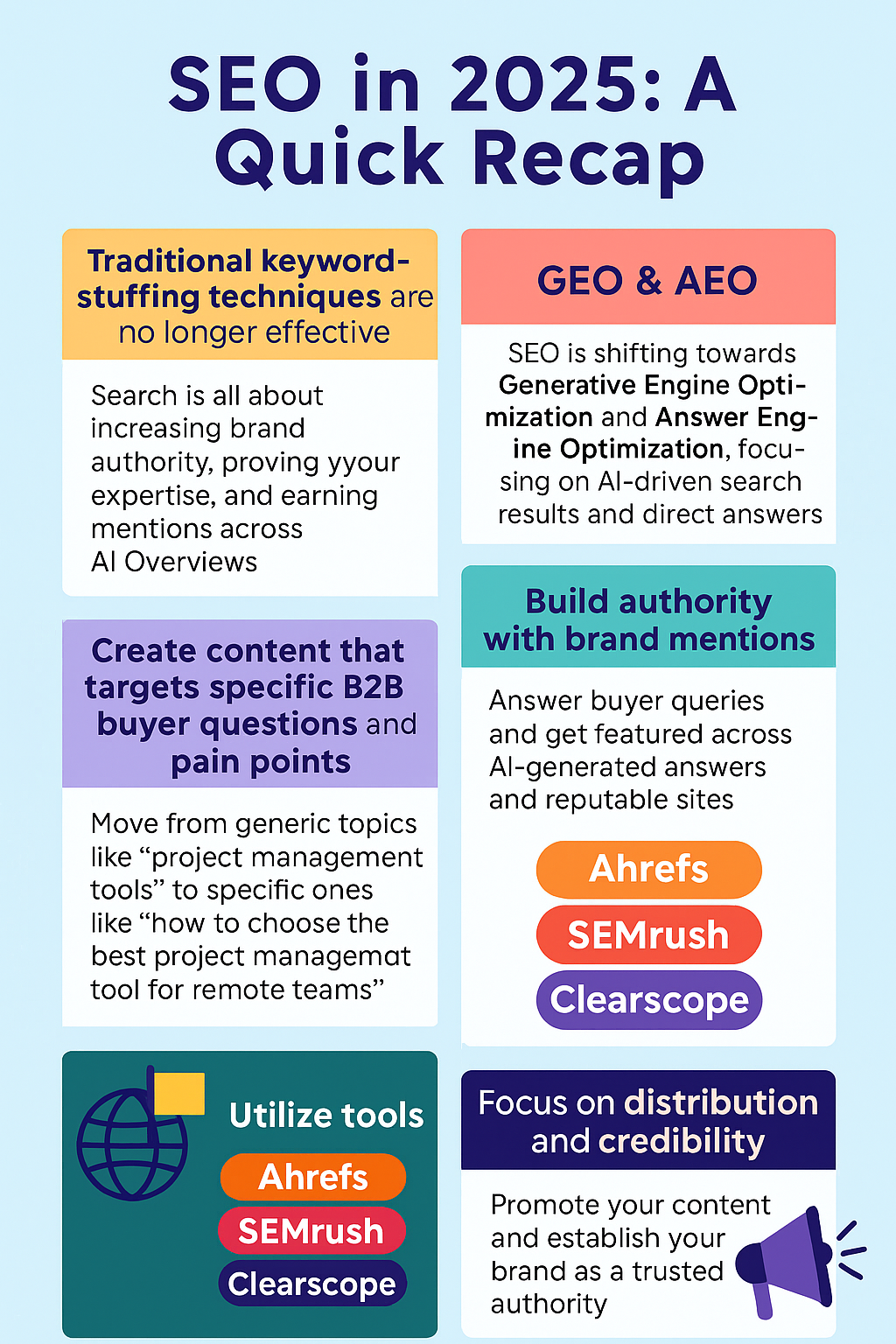
Further read: SaaS SEO: A Complete Guide from My 10 Years of Experience
‘Build-along growth series’? What exactly is that?
A “build-along growth series” is a content format where someone, like a founder or marketer, shares step-by-step updates on building a project using their product. Instead of just talking about the product, they demonstrate how it solves real-world problems in real-time. This approach lets the audience follow the process, see the product’s value firsthand, and engage with the content. It’s a transparent and practical way to build trust and interest.
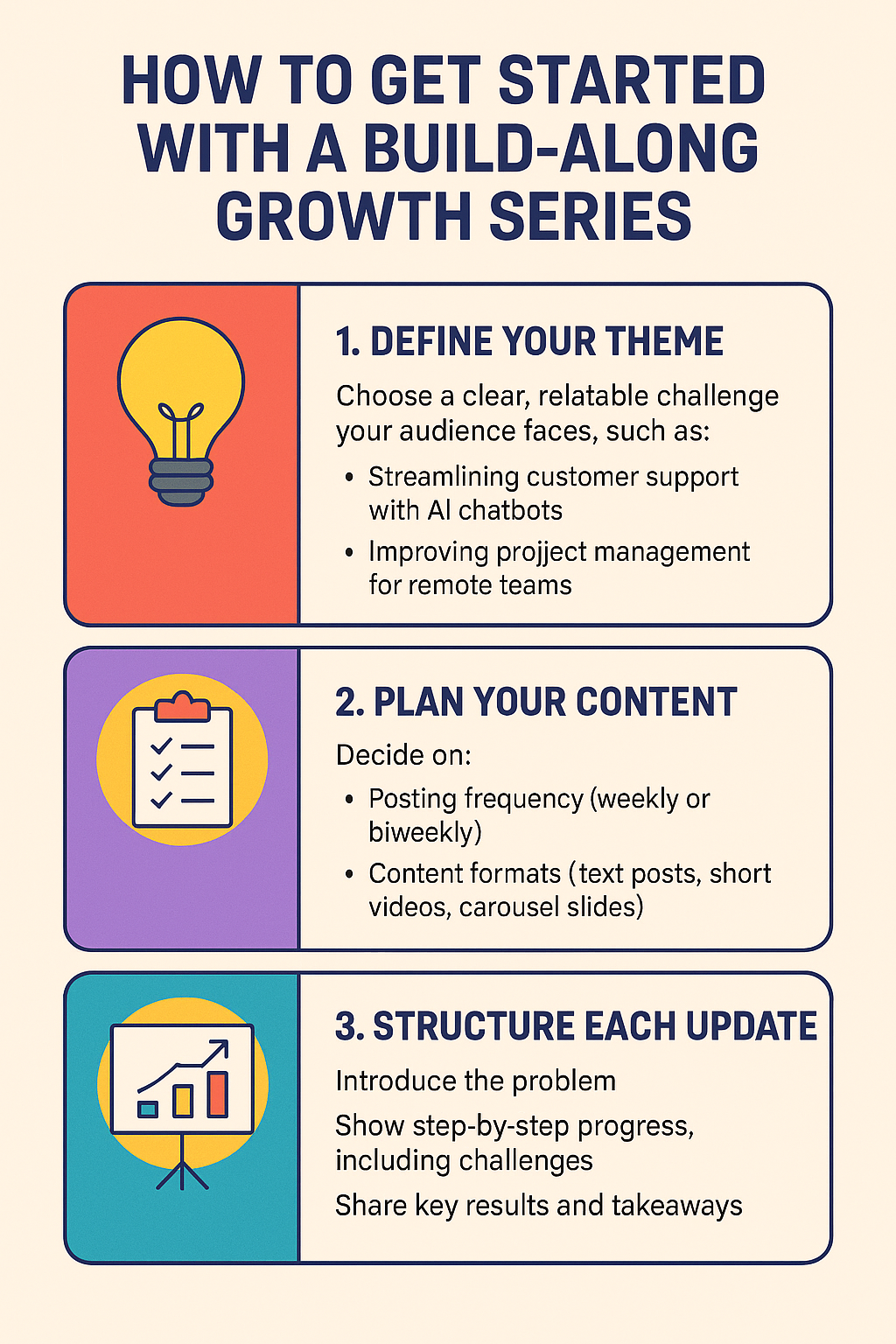
The rise of LinkedIn influencers, YouTube educators, and podcast hosts has transformed how B2B brands connect with their audiences. These creators are trusted voices within niche industries, such as Revenue Operations (RevOps), product marketing, or SaaS growth, and their followers look to them for expert insights and recommendations.
For instance, when Ruben Hassid, a leading AI influencer on LinkedIn, endorses a product, it goes beyond a simple recommendation. His trusted expertise and reputation in the AI community add genuine credibility. By aligning his name with a product, he vouches for its value and reliability, ensuring his audience sees the endorsement as authentic and trustworthy.
Similarly, creator-led B2B marketing uses the power of authentic voices, say, LinkedIn influencers, YouTube educators, and podcast hosts. This is because these voices have a deep understanding of their niche audiences and drive meaningful engagement. Unlike traditional ads, creator collaborations build trust by delivering expert insights that resonate with decision-makers.
Today, the bar for B2B content is high.
It needs to meet customer expectations without compromising their trust. Creator-led B2B influencing meets these high content standards by using real, trusted voices who share clear, expert stories that build confidence. Instead of just talking about features, these creators show how brands become reliable partners focused on delivering real results, helping sellers connect better with their key customers.
A personal and often underrated B2B growth strategy is to openly share what you’re building, testing, or learning. Building in public has become a significant trend in B2B marketing, offering brands a transparent and engaging way to connect with their audience. For instance,
A building-in-public approach creates multiple touchpoints with your audience, increasing visibility, developing trust, and generating valuable feedback to improve your product. By being transparent about successes and challenges, you humanize your brand and build a loyal community invested in your growth. This approach works exceptionally well for founders, creators, and product teams on platforms like LinkedIn and Twitter/X. By doing so, you attract early adopters and build your brand organically, laying a strong foundation before launching outbound or paid campaigns.
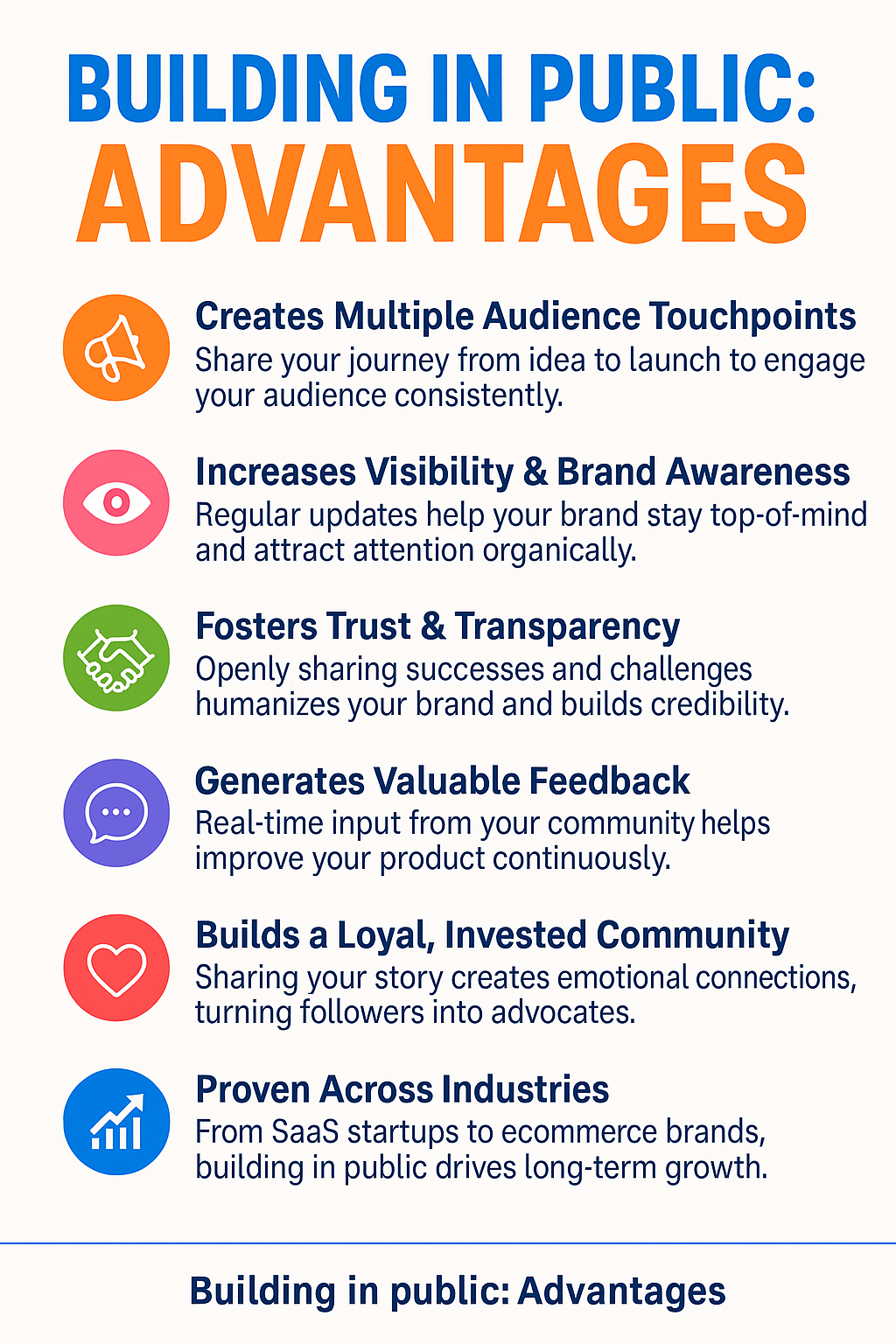
Strategic partnerships are a powerful way to accelerate B2B growth by reaching new, warm audiences faster than traditional cold outreach. By collaborating with complementary businesses through co-marketing efforts, such as joint webinars, shared content, or social campaigns, companies can pool resources, reduce costs, and tap into each other’s trusted audiences. For instance, HubSpot and Canva have partnered to embed Canva’s full design experience and Magic Studio AI tools directly into HubSpot’s platform, allowing teams to design, collaborate, and publish content seamlessly within their HubSpot portal via a native “Design with Canva” button.
Likewise, referral programs are another underrated marketing strategy to attract new potential customers by incentivizing your existing ones to recommend your product to others. For example, Dropbox's referral program offered users additional storage space for each new user they referred to, leading to a 3,900% growth in just 15 months. These programs lower acquisition costs and boost loyalty when designed with valuable incentives and an easy referral process.
Similarly, integration partnerships boost your product’s value by linking it with popular tools your customers already use, helping you reach more people and grow adoption. For instance, HubSpot, a CRM tool, and Shopify, an online store platform, combine to share customer information, support sales growth, and help create effective marketing messages.
Hosting webinars, events, and live demos is a powerful strategy for generating B2B leads and educating users. By addressing real-world problems, such as “How to Reduce Churn With Product Usage Data”, you can engage your audience effectively. These sessions provide immediate value and serve as long-term content assets. After the event, you can repurpose the content into blogs, LinkedIn posts, YouTube videos, and email newsletters to maximize your reach and impact. This approach ensures that your insights continue to engage and educate your audience across multiple platforms.
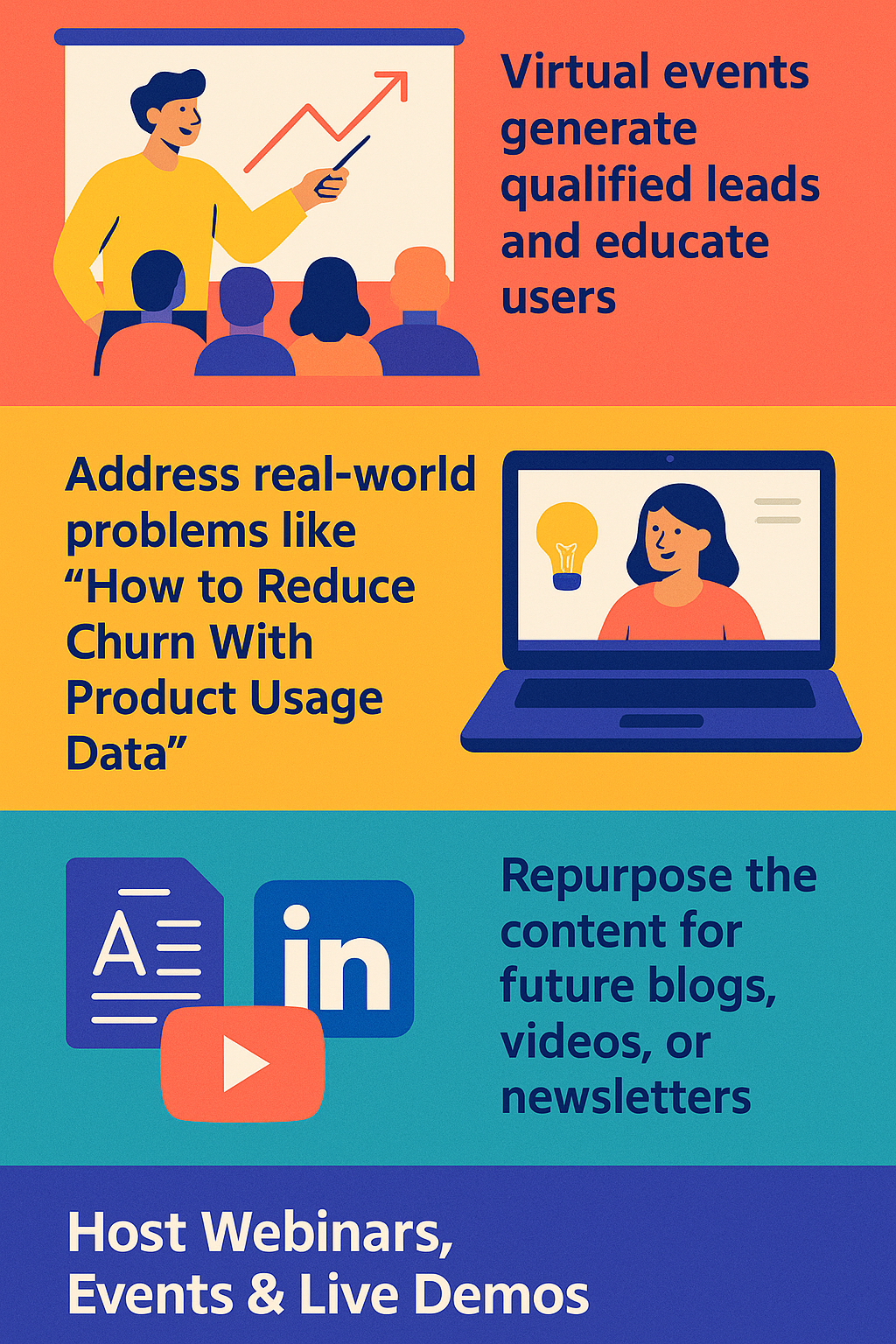
Yeah, outbound strategies, when done right, still work wonders in 2025. Cold email, cold calling, and LinkedIn outreach remain effective when executed with personalization and insight. For instance, outbound sales tools like Apollo, Clay, and Smartlead have revolutionized traditional cold outreach methods by introducing automation, personalization, and data-driven insights. These platforms empower sales teams to engage prospects more effectively and efficiently.

However, success in outbound today depends heavily on quality over quantity. Blanket outreach no longer cuts it. Buyers expect relevant, timely messages that demonstrate a clear understanding of their needs. That means investing time in research, crafting personalized scripts, and following up thoughtfully. Combining outbound efforts with strong inbound support, such as content marketing and social proof, also helps warm leads and build trust before the first call.
Account-Based Marketing (ABM) is a strategic approach where businesses focus their marketing efforts on a select group of high-value target accounts, treating each as a unique market. This method contrasts with traditional marketing, which often casts a wide net to attract a broad audience.
ABM is particularly effective in B2B contexts, especially when dealing with enterprise-level clients or complex sales processes. ABM is ideal for high-value, low-volume sales motions, where the focus is on building deep, long-term relationships with a select group of accounts rather than trying to reach a large number of potential leads. By concentrating resources on these key accounts, businesses can increase their chances of conversion and drive significant revenue growth.
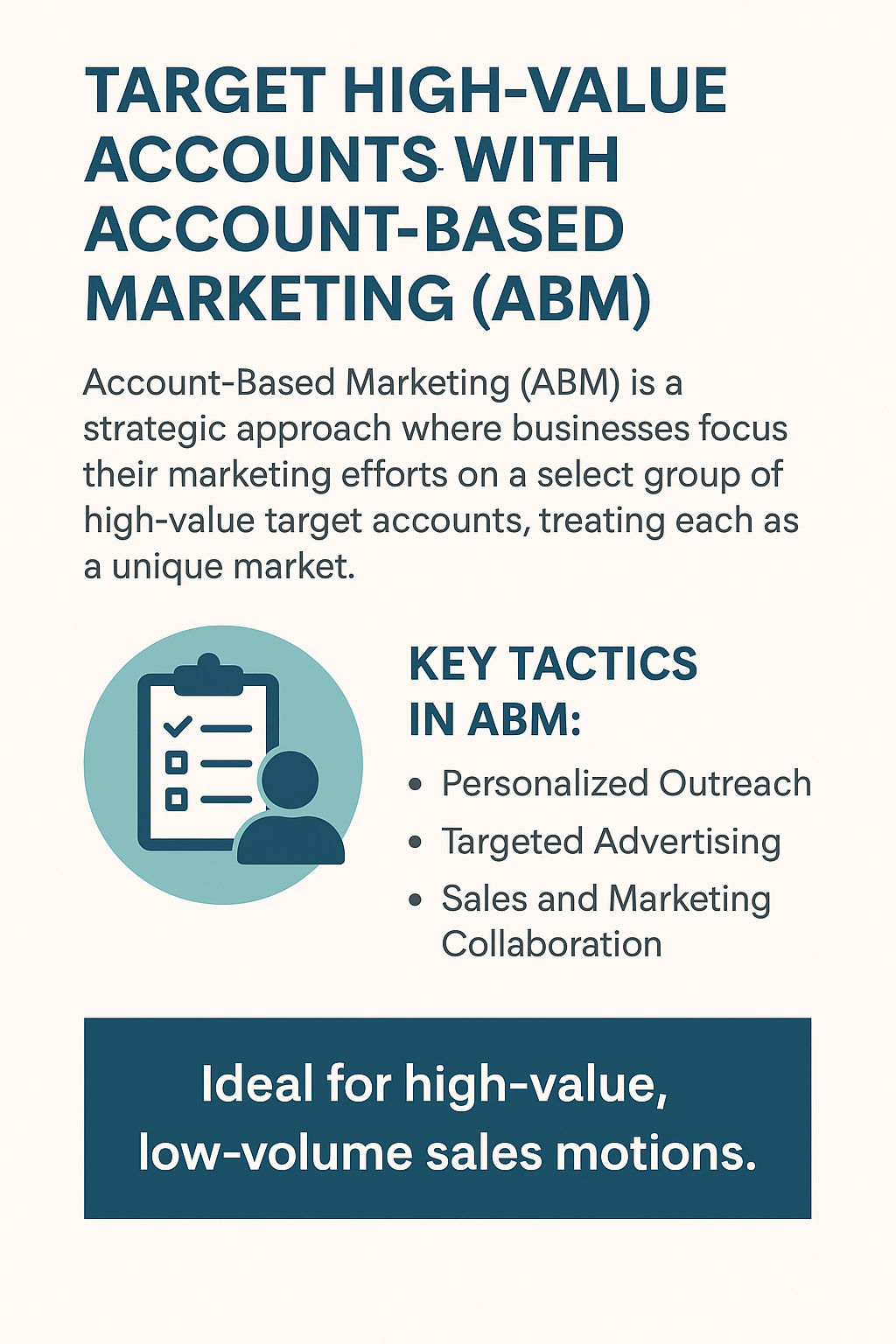
Product-Led Growth (PLG) is a strategy where the product itself drives user acquisition, activation, and retention. Instead of relying heavily on sales teams or marketing campaigns, PLG focuses on delivering immediate value to users through the product experience. This approach is particularly effective for SaaS companies offering free trials or freemium models, allowing users to experience the product's value before making a financial commitment. For example, Notion provides a freemium model with an intuitive interface, allowing users to create and organize content effortlessly. Similarly, Figma gives a free tier with collaborative design tools, enabling teams to work together in real-time. As the product itself drives growth, companies can scale without a proportional increase in sales or marketing expenses.
In essence, PLG shifts the focus from traditional sales-driven strategies to creating a product that sells itself. By prioritizing user experience and value, companies can achieve sustainable growth and build a loyal customer base.
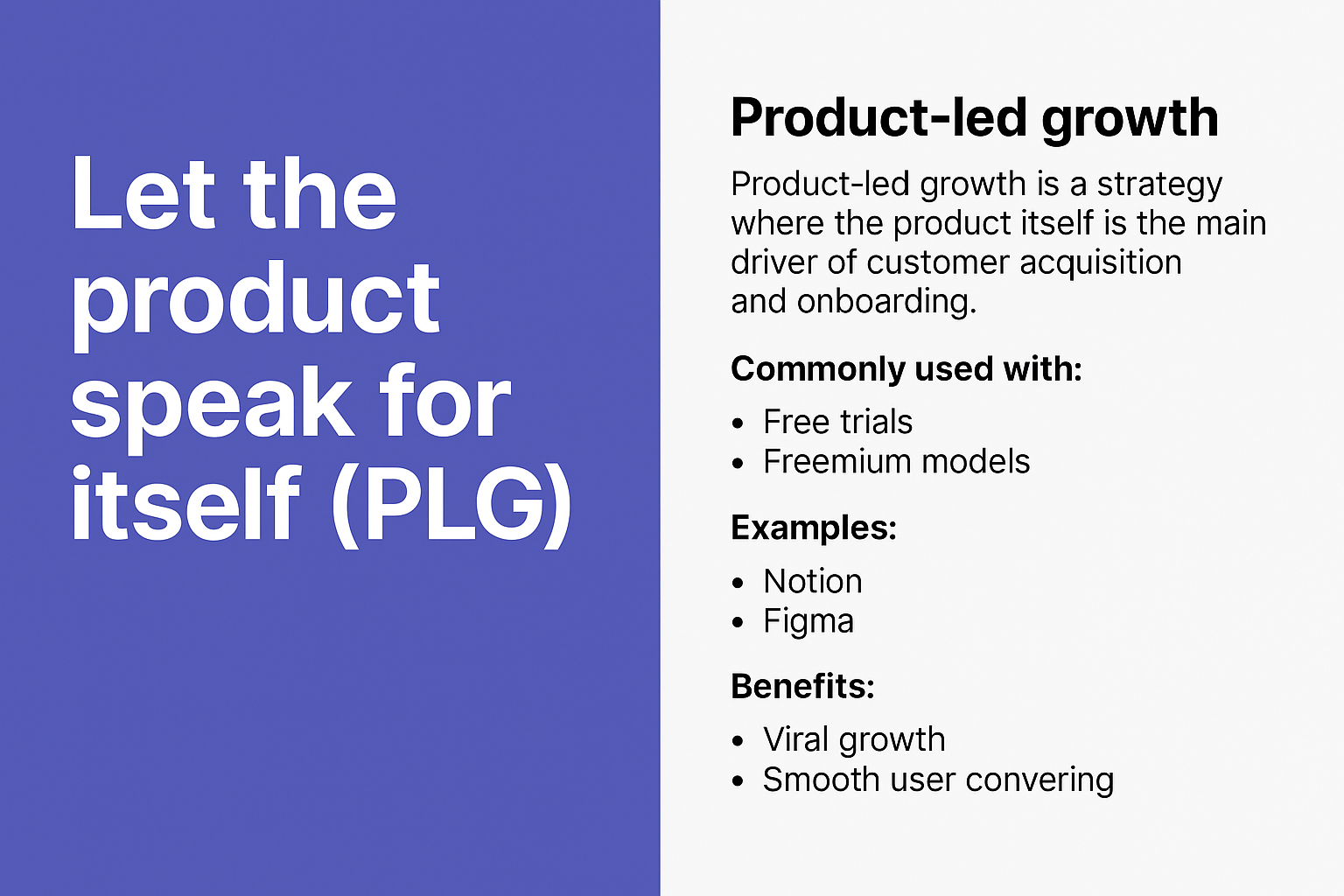
Launching a referral program that feels exclusive can significantly boost engagement and brand loyalty in the B2B space. Instead of relying on generic “give $10, get $10” incentives, design programs that reward influence and commitment.
Here are some ideas from the ONSAAS team to help you launch a referral program that feels tailor-made for each of your customers:
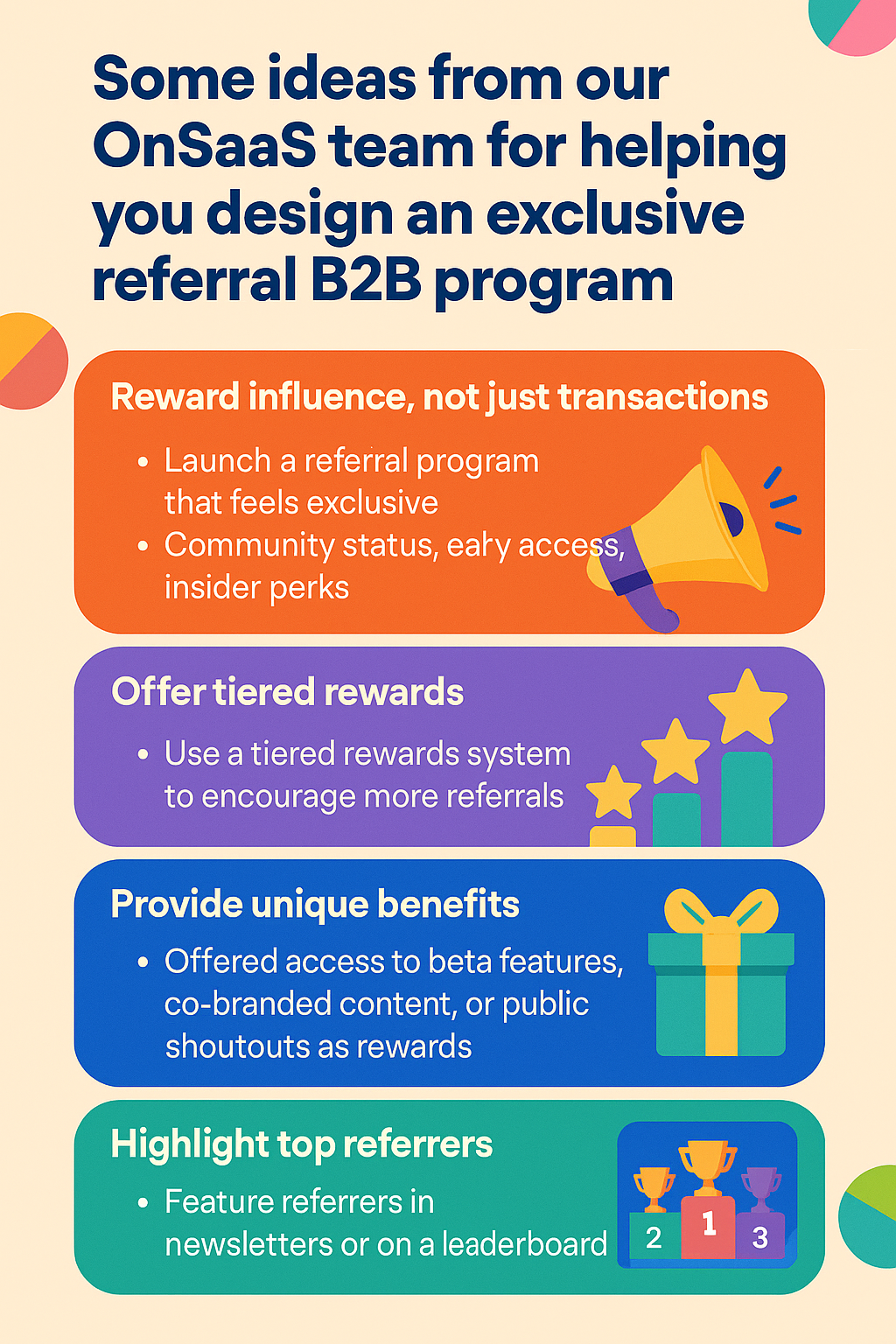
Encouraging user-generated content (UGC) is a powerful way to showcase authentic product use and build trust. Invite your customers to share their experiences with your product by posting on LinkedIn, sharing screenshots, creating Loom walkthroughs, or simply posting on social media. This method
You can provide incentives to motivate your customers to create and share content. You can also reshare great UGC’s on your official LinkedIn page, as a morale booster.
The incentives can be in the form of
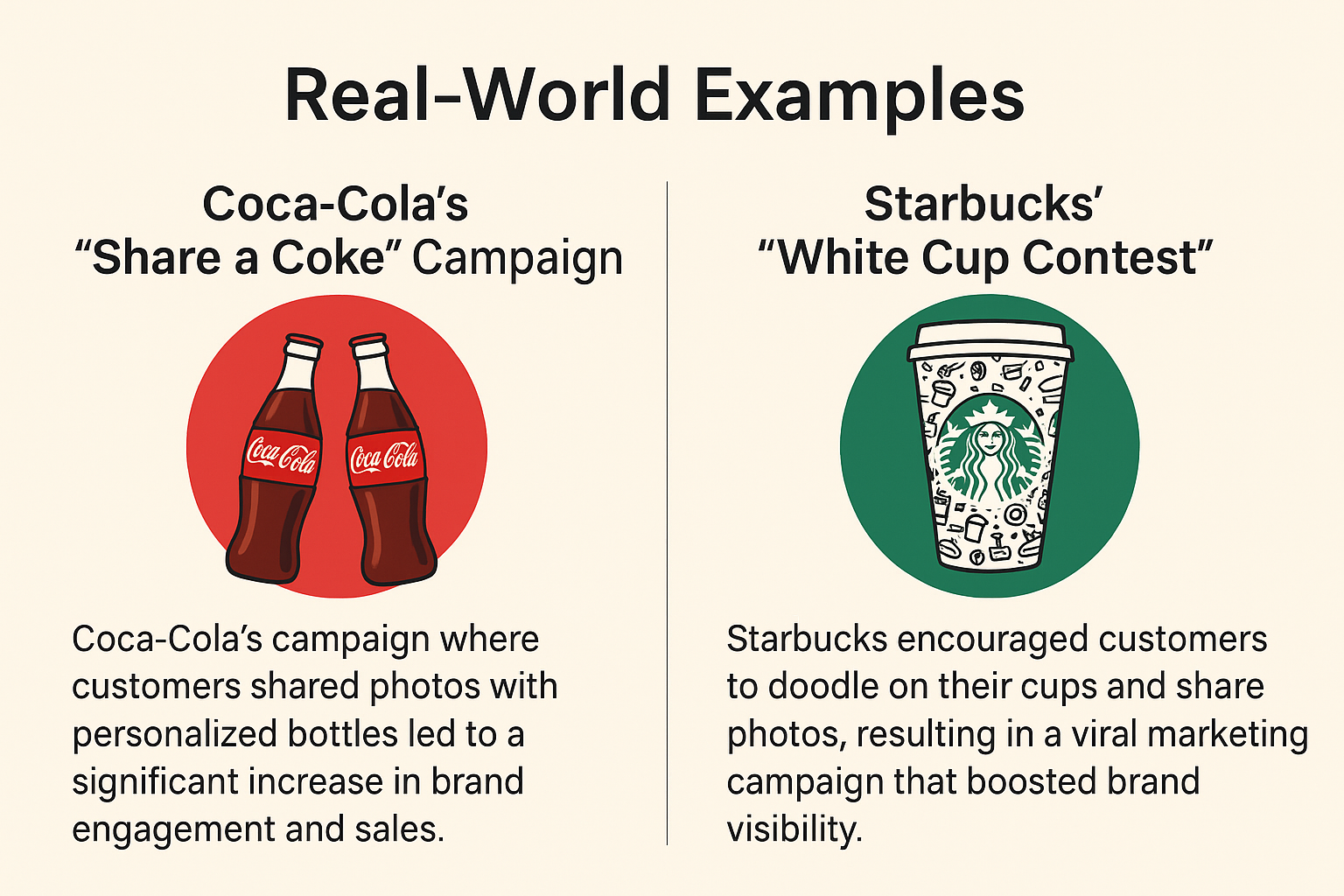
Creating industry benchmarks using aggregated customer data is a powerful B2B growth strategy that enhances credibility, attracts leads, and positions your brand as a thought leader. By analyzing anonymized data from your product usage or customer surveys, you can publish benchmark reports tailored to your target audience's interests, such as “Average email reply rates across SaaS” or “Median churn rates by company size.” For example, a SaaS company analyzing its customer data discovers that the average email reply rate across its user base is 20%. By publishing this benchmark, the company provides valuable insights to its audience and attracts potential customers interested in improving their email engagement strategies.
Growing a B2B company in 2025 is challenging but not impossible. The key lies in mastering the fundamentals, defining a focused ICP, clarifying your value proposition, and aligning your teams around shared goals. From there, combining smart content strategies, authentic creator partnerships, strategic alliances, and data-driven outreach creates a powerful growth engine built to last.
Remember, there’s no silver bullet.
Success requires patience, consistent experimentation, and a relentless focus on delivering real value to the right audience. By embracing these proven strategies and staying adaptable, your B2B business can cut through the noise, build genuine trust, and drive sustainable growth, today and well into the future.
.jpg)
Gayathri Gopalan is a B2B SaaS content and SEO specialist with 6+ years’ experience crafting search-optimized articles that rank, drive traffic, and convert. Her work has been featured in Women on Business, Rights of Equality, One Green Planet, and The Doof Media. Gayathri delivers well-researched, no-fluff content, from long-form articles to executive ghostwriting, aligning each piece with business goals for maximum impact.